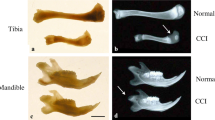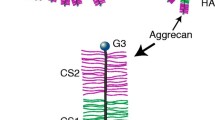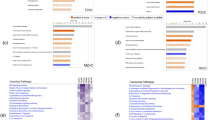Abstract
A disintegrin and metalloproteinase with thrombospondin motif (adamalysin–thrombospondins, ADAMTS) degrades aggrecan, one of the major extracellular matrix (ECM) components in cartilage. Mandibular condylar cartilage differs from primary cartilage, such as articular and growth plate cartilage, in its metabolism of ECM, proliferation, and differentiation. Mandibular condylar cartilage acts as both articular and growth plate cartilage in the growing period, while it remains as articular cartilage after growth. We hypothesized that functional and ECM differences between condylar and primary cartilages give rise to differences in gene expression patterns and levels of aggrecan and ADAMTS-1, -4, and -5 during growth and aging. We employed in situ hybridization and semiquantitative RT-PCR to identify mRNA expression for these molecules in condylar cartilage and primary cartilages during growth and aging. All of the ADAMTSs presented characteristic, age-dependent expression patterns and levels among the cartilages tested in this study. ADAMTS-5 mainly contributed to ECM metabolism in growth plate and condylar cartilage during growth. ADAMTS-1 and ADAMTS-4 may be involved in ECM turn over in articular cartilage. The results of the present study reveal that ECM metabolism and expression of related proteolytic enzymes in primary and secondary cartilages may be differentially regulated during growth and aging.







Similar content being viewed by others
References
Abbaszade I, Liu RQ, Yang F, Rosenfeld SA, Ross OH, Link JR, Ellis DM, Tortorella MD, Pratta MA, Hollis JM, Wynn R, Duke JL, George HJ, Hillman MC Jr, Murphy K, Wiswall BH, Copeland RA, Decicco CP, Bruckner R, Nagase H, Itoh Y, Newton RC, Magolda RL, Trzaskos JM, Burn TC et al (1999) Cloning and characterization of ADAMTS11, an aggrecanase from the ADAMTS family. J Biol Chem 274:23443–23450
Arner EC (2002) Aggrecanase-mediated cartilage degradation. Curr Opin Pharmacol 2:322–329
Arner EC, Pratta MA, Trzaskos JM, Decicco CP, Tortorella MD (1999) Generation and characterization of aggrecanase. A soluble, cartilage-derived aggrecan-degrading activity. J Biol Chem 274:6594–6601
Bae JW, Takahashi I, Sasano Y, Onodera K, Mitani H, Kagayama M, Mitani H (2003) Age-related changes in gene expression patterns of matrix metalloproteinases and their collagenous substrates in mandibular condylar cartilage in rats. J Anat 203:235–241
Caterson B, Flannery CR, Hughes CE, Little CB (2000) Mechanisms involved in cartilage proteoglycan catabolism. Matrix Biol 19:333–344
Doege KJ, Sasaki M, Kimura T, Yamada Y (1991) Complete coding sequence and deduced primary structure of the human cartilage large aggregating proteoglycan, aggrecan. Human-specific repeats, and additional alternatively spliced forms. J Biol Chem 266:894–902
Fosang AJ, Last K, Maciewicz RA (1996) Aggrecan is degraded by matrix metalloproteinases in human arthritis. Evidence that matrix metalloproteinase and aggrecanase activities can be independent. J Clin Invest 98:2292–2299
Gepstein A, Arbel G, Blumenfeld I, Peled M, Livne E (2003) Association of metalloproteinases, tissue inhibitors of matrix metalloproteinases, and proteoglycans with development, aging, and osteoarthritis processes in mouse temporomandibular joint. Histochem Cell Biol 120:23–32
Glasson SS, Askew R, Sheppard B, Carito B, Blanchet T, Ma HL, Flannery CR, Peluso D, Kanki K, Yang Z, Majumdar MK, Morris EA (2005) Deletion of active ADAMTS5 prevents cartilage degradation in a murine model of osteoarthritis. Nature 434:644–648
Kuno K, Okada Y, Kawashima H, Nakamura H, Miyasaka M, Ohno H, Matsushima K (2000) ADAMTS-1 cleaves a cartilage proteoglycan, aggrecan. FEBS Lett 478:241–245
Lark MW, Bayne EK, Flanagan J, Harper CF, Hoerrner LA, Hutchinson NI, Singer II, Donatelli SA, Weidner JR, Williams HR, Mumford RA, Lohmander LS (1997) Aggrecan degradation in human cartilage. Evidence for both matrix metalloproteinase and aggrecanase activity in normal, osteoarthritic, and rheumatoid joints. J Clin Invest 100:93–106
Lohmander LS, Neame PJ, Sandy JD (1993) The structure of aggrecan fragments in human synovial fluid. Evidence that aggrecanase mediates cartilage degradation in inflammatory joint disease, joint injury, and osteoarthritis. Arthritis Rheum 36:1214–1222
Luder HU, Leblond CP, von der Mark K (1988) Cellular stages in cartilage formation as revealed by morphometry, radioautography and type II collagen immunostaining of the mandibular condyle from weanling rats. Am J Anat 182:197–214
Matthews RT, Gary SC, Zerillo C, Pratta M, Solomon K, Arner EC, Hockfield S (2000) Brain-enriched hyaluronan binding (BEHAB)/brevican cleavage in a glioma cell line is mediated by a disintegrin and metalloproteinase with thrombospondin motifs (ADAMTS) family member. J Biol Chem 275:22695–22703
Mizoguchi I, Nakamura M, Takahashi I, Kagayama M, Mitani H (1992) A comparison of the immunohistochemical localization of type I and type II collagens in craniofacial cartilages of the rat. Acta Anat 144:59–64
Nakamura H, Fujii Y, Inoki I, Sugimoto K, Tanzawa K, Matsuki H, Miura R, Yamaguchi Y, Okada Y (2000) Brevican is degraded by matrix metalloproteinases and aggrecanase-1 (ADAMTS4) at different sites. J Biol Chem 275:38885–38890
Nakamura M, Sone S, Takahashi I, Mizoguchi I, Echigo S, Sasano Y (2005) Expression of versican and ADAMTS1, 4, and 5 during bone development in the rat mandible and hind limb. J Histochem Cytochem 53:1553–1562
Ohashi N, Ejiri S, Hanada K, Ozawa H (1997) Change in type I, II, and X collagen immunoreactivity of the mandibular condylar cartilage in a naturally aging rat model. J Bone Miner Metab 15:77–83
Ohtani H, Kuroiwa A, Obinata M, Ooshima A, Nagura H (1992) Identification of type I collagen-producing cells in human gastrointestinal carcinomas by non-radioactive in situ hybridization and immunoelectron microscopy. J Histochem Cytochem 40:1139–1146
Sandy JD, Verscharen C (2001). Analysis of aggrecan in human knee cartilage and synovial fluid indicates that aggrecanase (ADAMTS) activity is responsible for the catabolic turnover and loss of whole aggrecan whereas other protease activity is required for C-terminal processing in vivo. Biochem J 358:615–626
Sasano Y, Furusawa M, Ohtani H, Mizoguchi I, Takahashi I, Kagayama M (1996) Chondrocytes synthesize type I collagen and accumulate the protein in the matrix during development of rat tibial articular cartilage. Anat Embryol 194:247–252
Shibata S, Fukada K, Suzuki S, Ogawa T, Yamashita Y (2001) Histochemical localization of versican, aggrecan and hyaluronan in the developing condylar cartilage of the fetal rat mandible. J Anat 198:129–135
Silbermann M, Reddi AH, Hand AR, Leapman RD, von der Mark K, Franzen A (1987) Further characterization of the extracellular matrix in the mandibular condyle in neonatal mice. J Anat 151:169–188
Stanton H, Rogerson FM, East CJ, Golub SB, Lawlor KE, Meeker CT, Little CB, Last K, Farmer PJ, Campbell IK, Fourie AM, Fosang AJ (2005) ADAMTS5 is the major aggrecanase in mouse cartilage in vivo and in vitro. Nature 434:648–652
Sztrolovics R, Grover J, Cs-Szabo G, Shi SL, Zhang Y, Mort JS, Roughley PJ (2002) The characterization of versican and its message in human articular cartilage and intervertebral disc. J Orthop Res 20:257–266
Takahashi I, Mizoguchi I, Sasano Y, Saitoh S, Ishida M, Kagayama M, Mitnai H (1996) Age-related changes in the localization of glycosaminoglycans in condylar cartilage of the mandible in rats. Anat Embryol 194:489–500
Tang BL (2001) ADAMTS: a novel family of extracellular matrix proteases. Int J Biochem Cell Biol 33:33–44
Ten Cate AR (1994) Temporomandibular joint In: Ten Cate AR (ed) Oral histology: development, structure, and function, 4th edn. Mosby, St. Louis, pp 432–455
Tortorella MD, Burn TC, Pratta MA, Abbaszade I, Hollis JM, Liu R, Rosenfeld SA, Copeland RA, Decicco CP, Wynn R, Rockwell A, Yang F, Duke JL, Solomon K, George H, Bruckner R, Nagase H, Itoh Y, Ellis DM, Ross H, Wiswall BH, Murphy K, Hillman MC Jr, Hollis GF, Newton RC, Magolda RL, Trzaskos JM, Arner EC (1999) Purification and cloning of aggrecanase-1: a member of the ADAMTS family of proteins. Science 284:1664–1666
Tortorella M, Pratta M, Liu RQ, Abbaszade I, Ross H, Burn T, Arner E (2000) The thrombospondin motif of aggrecanase-1 (ADAMTS-4) is critical for aggrecan substrate recognition and cleavage. J Biol Chem 275:25791–25797
Zhu JX, Sasano Y, Takahashi I, Mizoguchi I, Kagayama M (2001) Temporal and spatial gene expression of major bone extracellular matrix molecules during embryonic mandibular osteogenesis in rats. Histochem J 33:25–35
Acknowledgments
We thank Dr. Manabu Kagayama, Professor Emeritus of the Graduate School of Dentistry, Tohoku University, Japan, for his instructions and valuable advice during this project. This research was supported by Grants-in-Aid (#11771308, #12557180, and #15390550) from the Japanese Ministry of Education, Culture, Sports, Science and Technology.
Author information
Authors and Affiliations
Corresponding author
Rights and permissions
About this article
Cite this article
Mitani, H., Takahashi, I., Onodera, K. et al. Comparison of age-dependent expression of aggrecan and ADAMTSs in mandibular condylar cartilage, tibial growth plate, and articular cartilage in rats. Histochem Cell Biol 126, 371–380 (2006). https://doi.org/10.1007/s00418-006-0171-8
Accepted:
Published:
Issue Date:
DOI: https://doi.org/10.1007/s00418-006-0171-8




